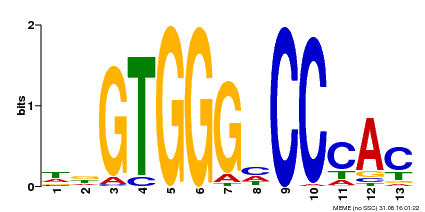- Riechmann JL, et al.
Arabidopsis transcription factors: genome-wide comparative analysis among eukaryotes.
Science, 2000. 290(5499): p. 2105-10
[PMID:11118137] - Dal Bosco C, et al.
Inactivation of the chloroplast ATP synthase gamma subunit results in high non-photochemical fluorescence quenching and altered nuclear gene expression in Arabidopsis thaliana.
J. Biol. Chem., 2004. 279(2): p. 1060-9
[PMID:14576160] - Yamada K, et al.
Empirical analysis of transcriptional activity in the Arabidopsis genome.
Science, 2003. 302(5646): p. 842-6
[PMID:14593172] - Wagner R,Pfannschmidt T
Eukaryotic transcription factors in plastids--Bioinformatic assessment and implications for the evolution of gene expression machineries in plants.
Gene, 2006. 381: p. 62-70
[PMID:16934950] - Marsch-Martinez N, et al.
BOLITA, an Arabidopsis AP2/ERF-like transcription factor that affects cell expansion and proliferation/differentiation pathways.
Plant Mol. Biol., 2006. 62(6): p. 825-43
[PMID:17096212] - Aguilar-Martínez JA,Poza-Carrión C,Cubas P
Arabidopsis BRANCHED1 acts as an integrator of branching signals within axillary buds.
Plant Cell, 2007. 19(2): p. 458-72
[PMID:17307924] - Yadav SR,Prasad K,Vijayraghavan U
Divergent regulatory OsMADS2 functions control size, shape and differentiation of the highly derived rice floret second-whorl organ.
Genetics, 2007. 176(1): p. 283-94
[PMID:17409064] - Ballvora A, et al.
Comparative sequence analysis of Solanum and Arabidopsis in a hot spot for pathogen resistance on potato chromosome V reveals a patchwork of conserved and rapidly evolving genome segments.
BMC Genomics, 2007. 8: p. 112
[PMID:17474978] - Ascencio-Ib
Global analysis of Arabidopsis gene expression uncovers a complex array of changes impacting pathogen response and cell cycle during geminivirus infection.
Plant Physiol., 2008. 148(1): p. 436-54
[PMID:18650403] - Giraud E, et al.
TCP transcription factors link the regulation of genes encoding mitochondrial proteins with the circadian clock in Arabidopsis thaliana.
Plant Cell, 2010. 22(12): p. 3921-34
[PMID:21183706] - Viola IL,Uberti Manassero NG,Ripoll R,Gonzalez DH
The Arabidopsis class I TCP transcription factor AtTCP11 is a developmental regulator with distinct DNA-binding properties due to the presence of a threonine residue at position 15 of the TCP domain.
Biochem. J., 2011. 435(1): p. 143-55
[PMID:21241251] - Kieffer M,Master V,Waites R,Davies B
TCP14 and TCP15 affect internode length and leaf shape in Arabidopsis.
Plant J., 2011. 68(1): p. 147-58
[PMID:21668538] - Arabidopsis Interactome Mapping Consortium
Evidence for network evolution in an Arabidopsis interactome map.
Science, 2011. 333(6042): p. 601-7
[PMID:21798944] - Li ZY,Li B,Dong AW
The Arabidopsis transcription factor AtTCP15 regulates endoreduplication by modulating expression of key cell-cycle genes.
Mol Plant, 2012. 5(1): p. 270-80
[PMID:21992944] - Uberti-Manassero NG,Lucero LE,Viola IL,Vegetti AC,Gonzalez DH
The class I protein AtTCP15 modulates plant development through a pathway that overlaps with the one affected by CIN-like TCP proteins.
J. Exp. Bot., 2012. 63(2): p. 809-23
[PMID:22016421] - Steiner E, et al.
The Arabidopsis O-linked N-acetylglucosamine transferase SPINDLY interacts with class I TCPs to facilitate cytokinin responses in leaves and flowers.
Plant Cell, 2012. 24(1): p. 96-108
[PMID:22267487] - Steiner E, et al.
Class I TCPs modulate cytokinin-induced branching and meristematic activity in tomato.
Plant Signal Behav, 2012. 7(7): p. 807-10
[PMID:22751297] - Viola IL,G
Redox modulation of plant developmental regulators from the class I TCP transcription factor family.
Plant Physiol., 2013. 162(3): p. 1434-47
[PMID:23686421] - Valsecchi I, et al.
The intrinsically disordered C-terminal region of Arabidopsis thaliana TCP8 transcription factor acts both as a transactivation and self-assembly domain.
Mol Biosyst, 2013. 9(9): p. 2282-95
[PMID:23760157] - Danisman S, et al.
Analysis of functional redundancies within the Arabidopsis TCP transcription factor family.
J. Exp. Bot., 2013. 64(18): p. 5673-85
[PMID:24129704] - Kim SH, et al.
The Arabidopsis immune adaptor SRFR1 interacts with TCP transcription factors that redundantly contribute to effector-triggered immunity.
Plant J., 2014. 78(6): p. 978-89
[PMID:24689742] - Mar
Large-scale identification of gibberellin-related transcription factors defines group VII ETHYLENE RESPONSE FACTORS as functional DELLA partners.
Plant Physiol., 2014. 166(2): p. 1022-32
[PMID:25118255] - Davi
Class I TCP-DELLA interactions in inflorescence shoot apex determine plant height.
Curr. Biol., 2014. 24(16): p. 1923-8
[PMID:25127215] - We
Convergent targeting of a common host protein-network by pathogen effectors from three kingdoms of life.
Cell Host Microbe, 2014. 16(3): p. 364-75
[PMID:25211078] - Chen GH,Sun JY,Liu M,Liu J,Yang WC
SPOROCYTELESS is a novel embryophyte-specific transcription repressor that interacts with TPL and TCP proteins in Arabidopsis.
J Genet Genomics, 2014. 41(12): p. 617-25
[PMID:25527103] - Resentini F, et al.
TCP14 and TCP15 mediate the promotion of seed germination by gibberellins in Arabidopsis thaliana.
Mol Plant, 2015. 8(3): p. 482-5
[PMID:25655823] - Peng Y, et al.
The ubiquitin receptors DA1, DAR1, and DAR2 redundantly regulate endoreduplication by modulating the stability of TCP14/15 in Arabidopsis.
Plant Cell, 2015. 27(3): p. 649-62
[PMID:25757472] - Lucero LE, et al.
TCP15 modulates cytokinin and auxin responses during gynoecium development in Arabidopsis.
Plant J., 2015. 84(2): p. 267-82
[PMID:26303297] - Viola IL,Camoirano A,Gonzalez DH
Redox-Dependent Modulation of Anthocyanin Biosynthesis by the TCP Transcription Factor TCP15 during Exposure to High Light Intensity Conditions in Arabidopsis.
Plant Physiol., 2016. 170(1): p. 74-85
[PMID:26574599] - Steiner E, et al.
The Putative O-Linked N-Acetylglucosamine Transferase SPINDLY Inhibits Class I TCP Proteolysis to Promote Sensitivity to Cytokinin.
Plant Physiol., 2016. 171(2): p. 1485-94
[PMID:27208284] - Dong H, et al.
Ubiquitylation activates a peptidase that promotes cleavage and destabilization of its activating E3 ligases and diverse growth regulatory proteins to limit cell proliferation in Arabidopsis.
Genes Dev., 2017. 31(2): p. 197-208
[PMID:28167503] - Zhang N, et al.
MOS1 functions closely with TCP transcription factors to modulate immunity and cell cycle in Arabidopsis.
Plant J., 2018. 93(1): p. 66-78
[PMID:29086441] - Mazur MJ, et al.
Arabidopsis TCP Transcription Factors Interact with the SUMO Conjugating Machinery in Nuclear Foci.
Front Plant Sci, 2017. 8: p. 2043
[PMID:29250092]
|





